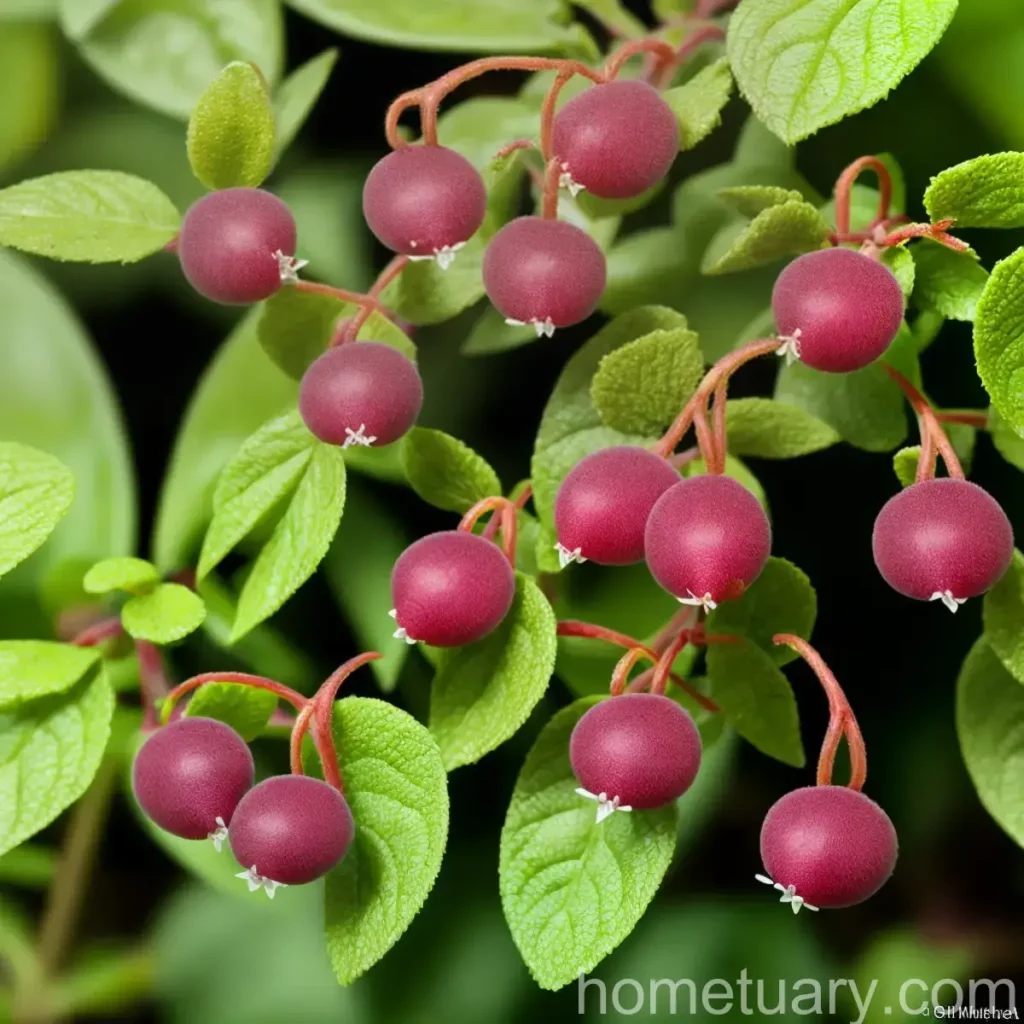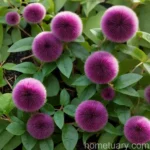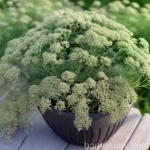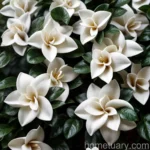Partridge Berry (Mitchella repens)
Partridge Berry (Mitchella repens) is a unique and fascinating plant that belongs to the Rubiaceae family. This perennial herbaceous plant is native to North America and can be found in various habitats ranging from shady woods to sandy soils. It possesses several intriguing characteristics and has a rich history of traditional uses, making it a noteworthy subject for plant enthusiasts and botanists. In this comprehensive guide, we will delve into the various aspects of the Partridge Berry plant, including its cultural significance, uses, care requirements, propagation methods, common diseases, and more.
Plant Name: Partridge Berry (Mitchella repens)
Before we delve into the specifics of Partridge Berry, let’s take a closer look at its scientific name. The botanical name for Partridge Berry is Mitchella repens. Mitchella is derived from the name of John Mitchell, an 18th-century Virginia botanist, and physician, who laid the foundation for the modern study of American flora. The species name, repens, is a Latin word that translates to “creeping,” signifying the plant’s characteristic creeping or trailing growth habit.
This blog post aims to provide a comprehensive understanding of the Partridge Berry plant, with a focus on its cultural significance, uses, care requirements, and unique characteristics. By exploring the key aspects of this plant, we aim to shed light on its ecological importance, traditional uses, and its potential as an ornamental and medicinal plant.
Let’s dive into the rich tapestry of Partridge Berry and uncover the fascinating world of this unique botanic specimen.
Key Takeaways – Partridge Berry (Mitchella repens)
Before we delve into the specific aspects of the Partridge Berry plant, let’s encapsulate its key takeaways:
- Scientific Name: Mitchella repens
- Family: Rubiaceae
- Common Name: Partridge Berry
- Habitat: Native to North America
- Cultural Significance: Significant in traditional and folklore practices
- Uses: Medicinal, ecological, and ornamental
- Unique Characteristics: Creeping habit, paired flowers, and distinctive berries
- Care Requirements: Shade-loving, moist soil, and minimal maintenance
- Propagation: By division or from seeds
- Challenges: Susceptible to certain diseases and pests
Plant Description
Botanical Characteristics
Partridge Berry (Mitchella repens) is a low-growing, perennial plant with a trailing or creeping growth habit. It typically reaches a height of 2-6 inches and spreads through stolons to form extensive ground cover. The leaves are evergreen and opposite, with a glossy, dark green appearance. One of the most distinctive features of Partridge Berry is the paired flowers that give rise to the unique appearance of its fruits.
Flowers and Fruits
The flowers of Partridge Berry are small, tubular, and white, often tinged with pink. What makes them particularly captivating is the fact that they emerge in pairs from a single ovary, resulting in a single red berry that retains the two distinct floral remnants at its apex. This characteristic creates a striking visual effect, making the plant highly sought after in landscaping and ornamental horticulture.
The berries of Partridge Berry ripen in late summer and persist through the winter, providing a valuable source of food for wildlife such as birds and small mammals. The vibrant red color of the berries adds a delightful touch to the winter landscape and makes them especially appealing for decorative purposes.
Distribution and Habitat
Partridge Berry is indigenous to North America and can be found in a wide range of habitats, including deciduous forests, shaded slopes, and dry woods. It has a broad geographic distribution, ranging from southern Canada to Georgia and as far west as Missouri and Texas. The plant thrives in moist, acidic soils and is often found in association with other woodland herbs and mosses.
Its ability to form dense, low-growing mats of foliage makes it an essential component of the forest understory, contributing to soil stabilization, moisture retention, and the ecological balance of its native habitats.
Ethnobotanical Significance
The Partridge Berry plant holds a significant place in the traditional practices and folklore of indigenous cultures. It has been used for a variety of medicinal, culinary, and ceremonial purposes, reflecting the deep-rooted connection between native communities and the natural world. The berries, in particular, have been valued for their nutritional and medicinal properties, and the plant as a whole has been revered for its resilience and adaptability.
As we embark on a journey to explore the multifaceted nature of Partridge Berry, we will unravel its uses, care requirements, and the cultural significance that has shaped its place in the botanical realm.
Culture
Uses
Partridge Berry holds a special place in the realm of traditional medicine and has been utilized by indigenous cultures for its various therapeutic benefits. The plant has been traditionally employed to address a range of health concerns, and its berries, leaves, and stems have been incorporated into herbal preparations and remedies.
Medicinal Uses
The medicinal properties of Partridge Berry have been an integral aspect of its cultural significance. The plant has been valued for its astringent, diuretic, and tonic properties, and has been used to address conditions such as urinary tract infections, digestive issues, and women’s health concerns. The leaves and stems of Partridge Berry have been prepared as herbal infusions or decoctions, while the berries have been used as a food source and for their potential medicinal benefits.
Ecological Significance
In addition to its traditional uses, Partridge Berry plays a crucial role in the ecological landscape. Its ability to form extensive ground cover and provide year-round foliage and berries makes it an important resource for wildlife. The berries serve as a food source for various bird species, contributing to the biodiversity and sustenance of forest ecosystems.
Ornamental Value
The distinctive appearance of Partridge Berry, with its glossy evergreen leaves and striking red berries, has made it a prized addition to ornamental landscapes and garden designs. Its ability to thrive in shade and form dense ground cover makes it an attractive choice for woodland gardens, rock gardens, and naturalistic landscapes. The plant’s adaptability to diverse soil conditions and its low maintenance requirements further enhance its appeal as an ornamental plant.
Culinary Uses
While Partridge Berry is primarily valued for its medicinal and ecological contributions, it has also found application in culinary practices. The berries, with their tart flavor and vibrant color, have been used in traditional recipes and preparations, adding a unique twist to culinary creations.
As we explore the diverse uses and applications of Partridge Berry, it becomes evident that this plant holds a multifaceted significance, encompassing aspects of traditional medicine, ecological sustainability, ornamental horticulture, and culinary innovation.
Care Requirements
Water
Partridge Berry thrives in moist, well-drained soils and benefits from regular watering, especially during dry periods. While the plant exhibits some tolerance to drought, consistent moisture is essential for its healthy growth and berry production. When cultivating Partridge Berry, it is important to provide adequate water to sustain its lush foliage and promote the development of its distinctive red berries.
Sunlight
Partridge Berry is well-suited to shaded or partially shaded environments and demonstrates a preference for woodland settings with dappled sunlight. It thrives under the canopy of deciduous trees or in areas with filtered light, where it can benefit from the gentle illumination without being exposed to direct sunlight. When selecting a site for Partridge Berry, it is important to prioritize shaded or semi-shaded locations to provide an optimal environment for its growth.
Fertilizer
As a shade-loving ground cover, Partridge Berry has modest fertilizer requirements and can thrive in nutrient-poor soils. Excessive fertilization can lead to excessive vegetative growth and may compromise the plant’s natural habit. However, a light application of balanced organic fertilizer in the spring can provide a gentle boost to the plant’s growth and help maintain its vigor.
Soil
Partridge Berry thrives in acidic, well-drained soils with a rich organic content. It is well-suited to woodland soils with a pH range of 4.5 to 5.5 and benefits from the presence of organic matter such as leaf litter, compost, or well-rotted mulch. When establishing Partridge Berry, it is important to ensure that the soil provides the ideal conditions for its growth, including sufficient acidity and good drainage.
Pruning
One of the distinct advantages of Partridge Berry is its low maintenance requirements, which include minimal pruning. As the plant spreads through stolons to form a dense ground cover, it naturally fills in bare areas and creates a lush carpet of foliage. Pruning is generally limited to the removal of any dead or damaged stems and the occasional trimming to maintain the desired shape and density.
Propagation
Partridge Berry can be propagated through division or from seeds, offering several options for expanding its presence in a garden or natural setting. Division involves separating the stolons and rooted stems of an established plant to create new colonies, while seed propagation can be accomplished with proper seed stratification and germination techniques. Both methods provide avenues for propagating Partridge Berry and increasing its presence in horticultural and ecological landscapes.
Container Popularity
While Partridge Berry is primarily valued for its ground cover capabilities in naturalistic settings, it can also be cultivated in containers for ornamental purposes. Its trailing growth habit and evergreen foliage make it an attractive choice for container gardening, offering a charming addition to shaded patios, balconies, and woodland-themed displays. The plant’s adaptability to containers expands its potential for use in diverse horticultural settings, further enhancing its popularity among gardeners and plant enthusiasts.
Common Diseases
Disease Diagnosis
Partridge Berry is generally resilient to most diseases and pests, owing to its adaptability and low maintenance requirements. However, it may be susceptible to certain fungal infections and leaf spots under conditions of poor air circulation or excessive moisture. Recognizing the symptoms of common diseases and promptly addressing any issues can help maintain the health and vitality of Partridge Berry in the landscape.
Common Pests
While Partridge Berry is relatively resistant to pest infestations, it may occasionally encounter challenges from insect pests such as aphids and scale insects. Routine monitoring and early intervention can help mitigate the impact of pests and preserve the plant’s overall health. Additionally, promoting natural predators and beneficial insects in the garden can contribute to the ecological balance and reduce the incidence of pest-related issues.
Botanist’s Tips
Growing Tips
When cultivating Partridge Berry, it is important to consider its unique growth habits and ecological preferences. Here are some valuable tips for successful Partridge Berry cultivation:
- Shade Optimization: Provide a shaded or partially shaded environment to accommodate the plant’s preference for dappled sunlight and cool, moist conditions.
- Moisture Management: Ensure consistent moisture, especially during dry periods, to support the plant’s lush foliage and berry production.
- Soil Considerations: Cultivate Partridge Berry in acidic, well-drained soils with a good organic content to create an ideal growing environment.
- Minimal Pruning: Embrace the plant’s low maintenance requirements and minimize pruning to maintain its natural habit and ground cover capabilities.
- Propagation Techniques: Explore division and seed propagation methods to expand the presence of Partridge Berry in the landscape and horticultural settings.
Wildlife Benefits
Partridge Berry serves as a valuable food source for wildlife, contributing to the sustenance and ecological balance of forest ecosystems. By incorporating Partridge Berry into gardens and natural landscapes, gardeners can create supportive habitats for birds and small mammals while adding a touch of natural beauty to the outdoor environment. The plant’s role in providing wildlife benefits underscores its ecological significance and adds a new dimension to its appeal in horticulture and environmental stewardship.
Disease Prevention
To minimize the risk of diseases and pests, it is important to provide adequate air circulation around the plants and to avoid overwatering. By maintaining proper growing conditions and employing proactive measures such as regular inspections and natural pest management strategies, gardeners can create a resilient growing environment for Partridge Berry. Observing best practices for disease prevention not only safeguards the health of the plant but also contributes to a sustainable and balanced ecosystem within the garden.
Fun Facts
As we unravel the captivating world of Partridge Berry, let’s explore a few fun facts that shed light on its unique attributes and cultural significance:
- The paired flowers of Partridge Berry give rise to a distinctive red berry, which has led to its association with the symbolism of unity and balance in various folklore and traditional narratives.
- Partridge Berry has been valued for its astringent properties and has been used in herbal medicine to address conditions such as diarrhea, rheumatism, and menstrual irregularities.
- Indigenous cultures have revered Partridge Berry for its resilience and adaptability, recognizing its ability to thrive in diverse environmental conditions and contribute to the sustenance of wildlife.
- The berries of Partridge Berry persist through the winter months and serve as a valuable food source for birds, enhancing the ecological value of the plant in forest habitats.
- Partridge Berry’s evergreen foliage and trailing growth habit make it a popular choice for naturalistic landscapes, where it creates a vibrant carpet of greenery and accommodates a diverse range of wildlife.
The allure of Partridge Berry extends beyond its botanical characteristics and encompasses a rich tapestry of traditional uses, cultural symbolism, and ecological contributions, making it a plant of enduring fascination and significance.
Links to External Resources
For those seeking further information on Partridge Berry and related topics, the following external resources provide valuable insights and perspectives:
- Partridge Berry: A Cultural History
- Medicinal Uses of Partridge Berry in Traditional Healing
- Wildlife Benefits of Partridge Berry in Forest Ecosystems
- Growing Tips for Ornamental Uses of Partridge Berry
- Folklore and Symbolism of Partridge Berry in Indigenous Cultures
These resources offer in-depth perspectives on the diverse aspects of Partridge Berry, including its cultural significance, ecological contributions, and practical considerations for cultivation and utilization.
In conclusion, the Partridge Berry (Mitchella repens) stands as a captivating exemplar of the intricate relationship between plants and human culture, ecological sustainability, and horticultural innovation. Its enduring appeal in traditional practices, landscape design, and ecological stewardship reaffirms its place as a plant of remarkable versatility and botanical significance.
As we celebrate the diverse uses, unique characteristics, and cultural significance of Partridge Berry, we gain a deeper appreciation for the rich tapestry of the natural world and the invaluable contributions of plants to our lives and environments.
Let’s continue to explore and cherish the botanical wonders that enrich our world, seeking inspiration from plants like Partridge Berry to cultivate a deeper understanding of nature’s bounty and the interconnectedness of all living beings.















